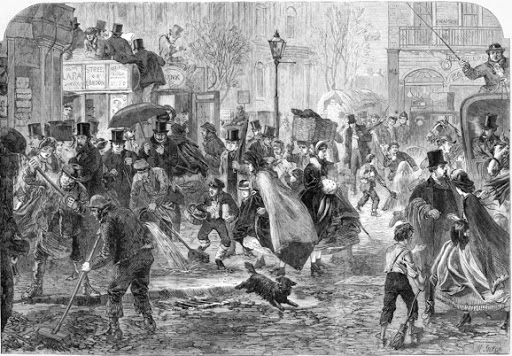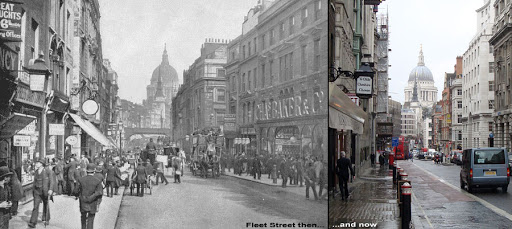street names
addresses
street signs & traffic lights
lanes
street lighting
maps
some kind of pattern in streets
street condition
Names? Many streets did not have names. They had just evolved from lanes and alleys as more and more people crowded into London. And, sometimes, even having a name wasn’t much of a help. In 1853, London had twenty-five Albert and twenty-five Victoria Streets, thirty-seven King and twenty-seven Queen Streets, twenty-two Princes, seventeen Dukes, thirty-four Yorks and twenty-three Gloucesters – and that was without counting the similarly named Places, Roads, Squares, Courts, Alleys or Mews, Rents, Rows, Gardens, Places, Buildings, Lanes, Yards and Walks. You could have: Albert Place, Albert Lane, Albert Walk, Albert Garden, Albert Rent, etc.

Street signs? like ‘Yield’ and ‘Stop’ and ‘No left turn’. Absolutely nonexistent in merry old London. Go when you want.
Traffic lights? Nope, see ‘street signs’ above.
Lanes? nah, everyone went where they wanted. There was no separation of traffic depending upon direction you were going. You could drive your carriage or ride your horse wherever you wanted in the street, left, right, middle. In fact, most people preferred the middle, the central lane, which usually was in the best repair - because, when people threw ‘slop’ out of their home, they usually hit the side of the street and not the middle.


Street patterns? Many of our cities have avenues and streets running in opposite directions. If you’re going to 1301 4th Ave. North, you go to the 13th street and the 4th avenue. Easy. In London there were East-West streets going into and out of the city. But there were no North-South roads. You had to go through a small lane or an alley or around the city.
Street condition? Dust, food, garbage, sewage, horse leavings, coal, ash, sand, grit all ground to dust by horses’ hooves and cart’s iron wheels. In wet weather it was shoveled to the sides of the roads before being loaded onto carts by scavengers employed by the parishes. These were called ‘crossing sweepers.’ Sometimes businesses hired boys to do this so that their clerks arrived at work with clean shoes and clean pants. The streets were terribly narrow; one popular street was 20’ wide. Most carriages were 6’ wide. If a brewers van needed 3 large horses harnessed abreast to move, it took the whole street.
And, the manure!!! Oh, my. In 1850 a study showed 1000 vehicles an hour passing through some streets during the day. All pulled by horses. Imagine the manure which had to be removed from the streets. Street sweepers attempted to keep the streets clean of manure but it was like using a thimble to empty the ocean.
Cattle were driven through the streets until the mid 1800’s. In an article for Household Words in March 1851 Dickens, with characteristic sarcasm, describes the environmental impact of having live cattle markets and slaughterhouses in the city:
"In half a quarter of a mile's length of Whitechapel, at one time, there shall be six hundred newly slaughtered oxen hanging up, and seven hundred sheep but, the more the merrier proof of prosperity. Hard by Snow Hill and Warwick Lane, you shall see the little children, inured to sights of brutality from their birth, trotting along the alleys, mingled with troops of horribly busy pigs, up to their ankles in blood but it makes the young rascals hardy. Into the imperfect sewers of this overgrown city, you shall have the immense mass of corruption, engendered by these practices, lazily thrown out of sight, to rise, in poisonous gases, into your house at night, when your sleeping children will most readily absorb them, and to find its languid way, at last, into the river that you drink."

Be thankful that you’re driving around today. But, again, most people walked wherever they needed to go and most did not stray further than a mile from home.
One other little bit I read: there was even a trade in used tea leaves. In most households, after the tea had been made, the leaves were rinsed, dried and sprinkled on the carpets before sweeping, to help collect the dust. Once this had been done, some charwomen sold the leaves to unscrupulous dealers who mixed them with new tea leaves, selling the tea at bargain prices.
Oh, yeah, here’s another bit: until the late 1800’s London residents were still drinking water from the river Thames where open sewers discharged. And, they wondered why there were cholera epidemics.
And, there you have it. Glad to be living in 2017.

No comments:
Post a Comment